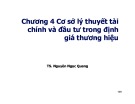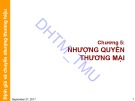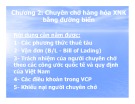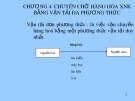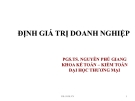
IN THIS CHAPTER, we provide a thorough overview of lodging valuation models. Hotel valuation, like all real estate valuation, must be
seen in the context of establishing a point estimate that represents the value of a unique, illiquid asset in an environment with noisy
and conflicting information. This gives rise to the use of multiple approaches that must be reconciled.
Appraisers are charged with estimating market value1 using the classic troika of the cost approach, the sales comparison
approach, and the income approach. Appraisers use "market" indicators of return requirements and other valuation parameters to
produce their estimates. Investors, on the other hand, wish to estimate investment value,2 which includes the effects of income taxes,
the investor's unique cost of capital, and other investor-specific conditions. Investors typically rely on a modified income approach
tailored to their circumstances, augmented with recent transaction information, to estimate value and form their bidding strategy.
Three Approaches to Hotel Valuation
In valuing hotels, there are three approaches from which to select: the income capitalization, sales comparison, and cost approach.
Although all three valuation approaches are generally given consideration, the inherent strengths of each approach and the nature of
the hotel in question must be evaluated to determine which approach will provide supportable value estimates. In addition, there is a
set of rules of thumb that are used to provide a rough estimate of value. Since hotel investors typically give more weight to it, the
income capitalization approach will be emphasized in this chapter.
In jurisdictions where ad valorem taxes are based on market value of real estate, hotel owners are concerned with separately
estimating the real property component (real estate) and the personal property component (both tangible and intangible personal
property).
Income Capitalization Approach
The income capitalization approach is based on the principle that the value of a property is indicated by its net return, or what is
known as the "present worth of future benefits." The future benefits of income-producing properties, such as hotels, are the net income
estimated by a forecast of income and expense along with the anticipated proceeds from a future sale. These benefits can be converted
into an indication of market value through a capitalization process and discounted cash flow analysis.
The forecast of income and expense is expressed in nominal or inflation-adjusted dollars for each of three years. The stabilized
year is intended to reflect the anticipated operating results of the property over its remaining economic life, given any or all applicable
stages of build-up, plateau, and decline in the life cycle of a hotel. Thus, income and expense estimates from the stabilized year
forward exclude from consideration any abnormal relationship between supply and demand, as well as any nonrecurring conditions
that may result in unusual revenues or expenses.
As stated in the textbook entitled Hotels and Motels: Valuations and Market Studies, "Of the three valuation approaches available
to the appraiser, the income capitalization approach generally provides the most persuasive and supportable conclusions when valuing
a lodging facility."3 The text goes on to state that using a ten-year forecast and an equity yield rate "most accurately reflects the actions
of typical hotel buyers, who purchase properties based on their leveraged discounted cash flow."4 The simpler procedure of using a
ten-year forecast and a discount rate (total property yield) is "less reliable because the derivation of the discount rate has little support.
Moreover, it is difficult to adjust the discount rate for changes in the cost of capital."5 Because of this difficulty, the procedure is not
illustrated in this chapter. A third income valuation technique is the "band of investment using one stabilized year." This technique is
appropriate when the local hotel market is not expected to experience any significant changes in supply and demand, so it can be
assumed that the subject property's net income has stabilized.
Sales Comparison Approach
While hotel investors are interested in the information contained in the sales comparison approach, they usually do not employ this
approach in reaching their final purchase decisions. Factors such as the lack of recent sales data, the numerous insupportable
adjustments that are necessary, and the general inability to determine the true financial terms and human motivations of comparable
transactions often make the results of this technique questionable. The sales comparison approach is most useful in providing a range
of values indicated by prior sales and in establishing an indicator of pricing momentum; however, reliance on this method beyond the
establishment of broad parameters is rarely justified by the quality of the sales data. The market-derived capitalization rates sometimes
used by appraisers are susceptible to the same shortcomings inherent in the sales comparison approach.
Cost Approach
The cost approach may provide a reliable estimate of value in the case of new properties, but as buildings and other improvements
grow older and begin to deteriorate, the resultant loss in value becomes increasingly difficult to quantify accurately. Most
knowledgeable hotel buyers base their purchase decisions on economic factors such as projected net income and return on investment.
Because the cost approach does not reflect these income-related considerations and requires a number of highly subjective depredation
estimates, this approach is given minimal weight in the hotel valuation process. However, it is useful in establishing a benchmark for
buy versus build decisions and for relative pricing over time.
Valuation for Assessment Purposes
The question arises of whether to separately estimate a hotel's real property and personal property components in the interest of
reducing the tax burden on the property. Such a practice it is hoped would not only reduce property taxes, but take advantage of much
shorter depreciation periods for goodwill as opposed to real property. There is no question that some portion of cash flows generated
by a hotel must be used to support the unique characteristics of the hotel investment, such as large continuing investment in furniture,
fixtures, and equipment (FF&E) and the need to employ specialized management to realize a property's potential. However, because
there is a significant financial incentive to attribute a portion of the going-concern value to intangible personal property, valuation of
the intangible property component of a hotel is contentious.6
Valuation of the real property and personal property components generally proceeds by establishing the overall net income before
any deductions for property taxes, FF&E funding, management fees, and franchise fees. Deductions are made for income attributable
to the business or going concern and tangible personal property, leaving what is generally called "net income" attributable to the real
estate. This remainder is capitalized at a capitalization rate to establish the value of the real estate component.








